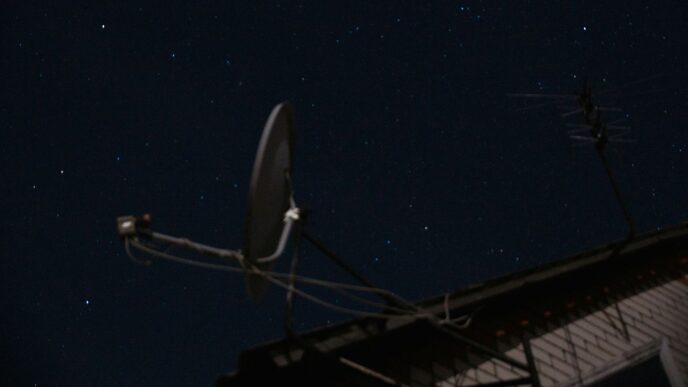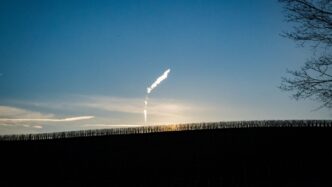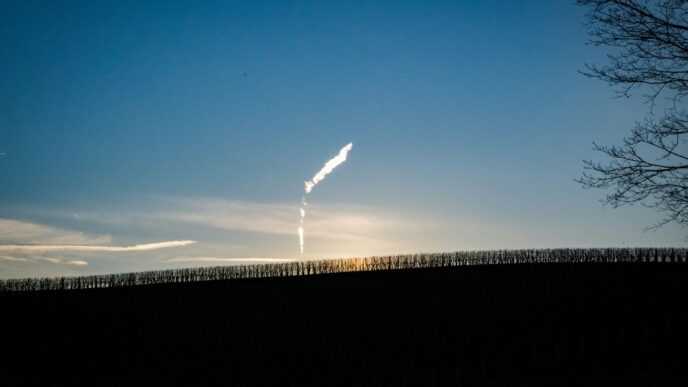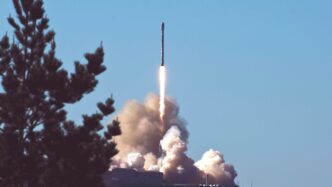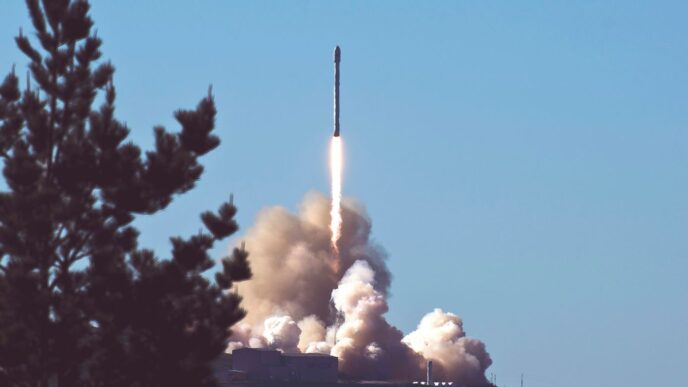Blue Origin is doing some really cool stuff in space, and a big part of that is their new project called Blue Ring. It’s supposed to change how we move things around in space, making it easier to get to different places and do more missions. This whole Blue Ring Blue Origin thing is a big deal for space travel, helping us go further and do more up there.
Key Takeaways
- Blue Ring helps with big problems in space travel, like building infrastructure and moving around in space.
- Blue Origin is working with other companies, like Redwire, to make Blue Ring happen, using things like special solar panels and cameras.
- The first Blue Ring test is going to launch on Blue Origin’s New Glenn rocket, checking out its communication and other systems.
- Blue Ring can move to different orbits, drop off payloads, and handle computing and communication tasks in space.
- This project is also important for national security, helping the Department of Defense with future space missions.
Blue Ring Blue Origin: Pioneering Space Mobility
Addressing Key Spaceflight Challenges
Spaceflight is hard, no secret there. Blue Origin’s Blue Ring aims to tackle some of the biggest headaches. We’re talking about the growing amount of stuff in space and the need to move things around more easily. Think of it like a space tow truck and delivery service all rolled into one. Blue Ring is designed to address these challenges head-on.
Multi-Mission Space Mobility Platform
Blue Ring isn’t just a one-trick pony. It’s designed to be a versatile platform for all sorts of missions. It can carry a hefty payload – up to 3,000 kilograms – and has multiple ports to accommodate different types of satellites. It can even handle those bigger ESPA Grande class satellites. The idea is to create a flexible system that can go where it’s needed, whether that’s GEO, cislunar space, or even further out.
Enabling Groundbreaking Missions
What does all this mean for space missions? Well, Blue Ring could open the door to some pretty cool stuff. Imagine deploying payloads exactly where they need to be, hosting experiments in different orbits, and providing onboard computing and communications. This could lead to breakthroughs in areas like space-based manufacturing, resource utilization, and even deep-space exploration. It’s about making space more accessible and useful for everyone. Blue Origin’s reusable rocket engines are a key part of this vision.
Blue Ring Blue Origin: Strategic Partnerships and Advanced Technology
Redwire Collaboration for Blue Ring
Blue Origin isn’t going it alone; they’re teaming up with some serious players to make Blue Ring a reality. One key partnership is with Redwire, who are providing some crucial tech. Redwire is building four Roll-Out Solar Array (ROSA) wings for Blue Ring, along with multiple Argus cameras and Low Voltage Distribution Units (LVDUs).
Redwire’s ROSA wings are super important because they’ll power the Blue Ring platform for missions way out in medium-Earth orbit and beyond. These ROSA wings are great because they fold up small for launch but then expand to provide a ton of power. They’ve already been used on the International Space Station (ISS) six times, and they were even part of NASA’s DART mission, which successfully changed the orbit of an asteroid. That’s a pretty good track record. This is important as Blue Origin is poised to lead the burgeoning space economy.
ROSA Wings for Powering Blue Ring
So, why are these ROSA wings such a big deal? Well, space missions need power, and lots of it. ROSA wings are designed to be lightweight and efficient, which is exactly what you want when you’re launching stuff into space. They pack tightly for launch and then unfurl once they’re in orbit, kind of like a party favor, but way more useful. The fact that they’ve been used on the ISS and in the DART mission shows that they’re reliable and ready for the challenges of space. It’s not just about having power; it’s about having a reliable power source that can handle the demands of long-duration missions.
Argus Camera Systems and LVDUs
Redwire isn’t just providing solar arrays; they’re also supplying Argus space camera systems and LVDUs. The Argus camera system is a modular imaging system that’s already been used in low-Earth orbit missions. It’s even planned for use on NASA’s Commercial Lunar Payload Services lunar landers. These cameras are pretty impressive; Redwire’s camera systems even captured images from NASA’s Artemis I mission. The LVDUs are also important because they distribute power to the different payloads and systems on Blue Ring. Basically, they make sure everything gets the power it needs, when it needs it. It’s all about having reliable space technology to make these missions successful.
Blue Ring Blue Origin: New Glenn’s Inaugural Mission
Blue Ring Pathfinder Payload Launch
So, New Glenn’s first flight? It’s a big deal. Instead of the NASA mission that was originally planned, it’s now carrying the Blue Ring Pathfinder. This is a tech demo for Blue Origin’s in-space mobility platform. The encapsulated payload was integrated onto the launch vehicle after the hotfire test. It’s all part of the Defense Innovation Unit’s Orbital Logistics prototype effort, which is pretty cool because it’s helping the Department of Defense out in the future. The launch is scheduled for January 16, 2025, at 07:03 UTC from Launch Complex 36 at Cape Canaveral Space Force Station.
Validating In-Space Communications
The Pathfinder is going to be busy. It’s got a communications array, power systems, and a flight computer all hooked up to a secondary payload adapter ring. The main goal? To make sure Blue Ring’s communications work from orbit to the ground. It’s also going to test the in-space telemetry, tracking, and command hardware. Plus, they’re checking out the ground-based radiometric tracking that they’ll use on the actual Blue Ring production spacecraft. The Blue Ring Pathfinder will stay on New Glenn’s second stage for about six hours during the mission.
Testing Core Flight Systems
This mission is all about testing. They want to validate Blue Ring’s core flight and ground systems. It’s a big step towards getting Blue Ring ready for real missions. The hotfire test was a major milestone. The integrated launch vehicle included the first and second stages of the NG-1 flight vehicle, and a payload test article comprised of manufacturing test demonstrator fairings, a high-capacity fixed adapter flight unit, and a 45,000 lb payload mass simulator. The New Glenn rocket is designed to be reusable, with the first stage returning to land on a landing barge at sea, similar to Falcon 9’s booster landings. Hopefully, the New Glenn launch is successful.
Blue Ring Blue Origin: Expanding In-Space Capabilities

Maneuvering to Multiple Orbits
Blue Ring’s design allows it to move between different orbits. This is a big deal because it means it can service a wider range of missions and destinations. It’s not stuck in one place; it can go where it’s needed. Think of it like a space-based taxi, picking up and dropping off payloads at various locations. This capability is enabled by advanced propulsion systems and precise navigation, making it a versatile asset for in-space operations.
Payload Deployment and Hosting
Blue Ring isn’t just about getting from point A to point B; it’s also about what it can do once it gets there. It can deploy payloads into their intended orbits, and it can also host payloads for extended periods. This hosting capability is useful for experiments, data collection, or even serving as a platform for other spacecraft. The platform can handle a substantial amount of mass, up to 3,000 kilograms, and has multiple ports to accommodate different types of payloads. This flexibility makes it a valuable resource for various space missions. Redwire’s innovative solutions in-space logistics are key to this capability.
Onboard Computing and Communications
Blue Ring has its own onboard computer and communication systems. This means it can perform tasks autonomously, without constant direction from Earth. It can process data, make decisions, and communicate with other spacecraft or ground stations. This is important for missions that require quick responses or that operate in areas where communication is limited. The onboard computing power also allows for more complex operations, such as real-time data analysis and adaptive mission planning. The demonstrator includes a communications array, power systems, and a flight computer affixed to a secondary payload adapter ring. Jean Rousseau’s leadership in business is an example of the kind of autonomy Blue Ring aims to achieve in space.
Blue Ring Blue Origin: Supporting National Security Objectives
Defense Innovation Unit Collaboration
Blue Origin is working with the Defense Innovation Unit (DIU) on the Orbital Logistics prototype. DIU’s support is helping to make future Department of Defense missions possible. The Blue Ring Pathfinder payload is part of this effort. It’s all about showing how Blue Ring can help with national security needs. This collaboration is a big deal for getting future DoD missions off the ground.
Enabling Future DoD Missions
Blue Ring is designed to handle a lot of different tasks, which makes it useful for the DoD. Its ability to move to different orbits and carry various payloads means it can support a wide range of missions. Think about things like deploying satellites, doing surveillance, or even providing in-space refueling. Blue Origin is trying to make sure Blue Ring can meet the specific needs of the military. It’s not just about building a cool spacecraft; it’s about making something that can really help with national security.
National Security Space Launch Certification
Getting certified for National Security Space Launch (NSSL) missions is a key goal for Blue Origin. This certification means that New Glenn, the rocket that will launch Blue Ring, meets the strict requirements for launching important national security payloads. It’s a long and tough process, but it’s important for showing that Blue Origin can be trusted with these critical missions. The Blue Ring Pathfinder mission is a step towards getting that certification, proving that the New Glenn rocket is up to the task.
Blue Ring Blue Origin: Integration with Blue Origin’s Ecosystem
Foundation for Lunar Presence
Blue Ring isn’t just about Earth orbits; it’s a stepping stone for Blue Origin’s larger ambitions, especially concerning lunar operations. Think of it as a crucial piece in the puzzle for establishing a sustained presence on the Moon. Blue Ring can pre-position resources and infrastructure in lunar orbit, making future lunar missions more efficient and cost-effective. It’s like setting up base camp before the climb. This includes delivering habitats, rovers, and other equipment needed for long-term lunar exploration and resource utilization. It all ties back to Blue Origin’s vision of expanding humanity’s reach into space.
Harnessing In-Space Resources
One of the most exciting possibilities with Blue Ring is its potential to support in-space resource utilization (ISRU). Imagine using resources found in space, like water ice on the Moon, to create fuel or other supplies. Blue Ring could play a key role in transporting equipment needed for ISRU, as well as moving the processed resources to where they’re needed. This could drastically reduce the cost of space missions by decreasing the amount of material that needs to be launched from Earth. It’s a long-term goal, but Blue Ring is designed to be adaptable to these future needs. The connected car mobility solutions market is expected to grow, and in-space resource utilization is a key part of that.
Multi-Mission, Multi-Orbit Mobility
Blue Ring’s design allows it to support a wide range of missions across different orbits. It’s not limited to just one type of task or one location in space. This versatility makes it a valuable asset for both commercial and government customers. Here’s a quick breakdown of its capabilities:
- Geosynchronous Orbit (GEO): Delivering and servicing satellites.
- Cislunar Space: Supporting lunar missions and resource utilization.
- Interplanetary Space: Transporting payloads to other planets.
Blue Origin’s BE-4 engines are a key component of the New Glenn rocket, which will launch Blue Ring. The ROSA wings provide power for Blue Ring, enabling it to perform these diverse missions. Blue Ring is designed to be a workhorse for space, capable of handling a variety of tasks and adapting to changing needs. It’s all about creating a more accessible and dynamic space environment.
Blue Ring Blue Origin: Future Prospects and Impact
Pushing Boundaries of Space Logistics
Blue Ring is poised to really shake things up in space logistics. It’s not just about moving stuff around; it’s about creating a whole new way of doing business in space. Imagine a future where satellites can be refueled, repaired, or even relocated in orbit. Blue Ring is a key piece of that puzzle, offering the mobility and flexibility needed to make it happen. It’s like having a space-based delivery and service truck, ready to go wherever it’s needed. This could drastically cut costs and boost the lifespan of space assets.
Advancing Space Exploration Technologies
This platform isn’t just for logistics; it’s also a testbed for new tech. Think about it:
- Testing new propulsion systems
- Evaluating advanced communication methods
- Experimenting with autonomous navigation
Blue Ring lets engineers push the limits in a real-world environment. The Argus space camera system and other components are examples of how existing tech is being adapted and improved for the unique challenges of space. It’s a stepping stone to even more ambitious missions, like lunar bases or deep-space exploration. The Roll-Out Solar Array (ROSA) wings are a great example of this, providing the power needed for extended missions.
Driving Collaborative Spirit in Space Industry
Blue Origin isn’t doing this alone. The collaboration with Redwire, for example, shows how important partnerships are in the space industry. By working together, companies can share expertise, reduce costs, and speed up innovation. This collaborative spirit is what will drive the next wave of space exploration and development. Blue Ring is a symbol of this, bringing together different technologies and capabilities to achieve common goals. It’s about building a foundation for lunar presence and beyond, together.
Conclusion
So, what does all this mean for space travel? Well, Blue Ring looks like it’s going to change a lot of things. It’s not just about getting stuff into space anymore; it’s about what you can do once you’re up there. With Blue Ring, we’re talking about moving things around, setting up experiments, and maybe even building things in orbit. It’s a big step toward making space more like a place we can actually work and live in, not just visit. It’s pretty exciting to think about what comes next.
Frequently Asked Questions
What exactly is Blue Ring?
Blue Ring is a special platform made by Blue Origin to help move things around in space. It’s like a space truck that can go to different places and drop off or pick up stuff. It’s built to solve big problems in space travel, like getting things where they need to go and setting up new space stations.
How is Redwire helping with Blue Ring?
Redwire is working with Blue Origin on Blue Ring. They are making important parts like the solar panels that power Blue Ring (called ROSA wings), special cameras (Argus), and power distribution units (LVDUs). These parts are super important for Blue Ring to work well in space.
When will Blue Ring fly for the first time?
The first time Blue Ring will fly is on Blue Origin’s New Glenn rocket. It will be a test flight to make sure everything works, like talking to Earth and checking all the systems. This first trip is a big step for Blue Ring and for Blue Origin’s plans in space.
What can Blue Ring do once it’s in space?
Blue Ring can do many things! It can move to different orbits, drop off satellites, and even host experiments. It has computers and communication gear onboard. It’s designed to carry a lot of different items, up to 3,000 kilograms, to various spots in space, including far out past the Moon.
How does Blue Ring help with national security?
Blue Ring is helping the U.S. government with its space plans, especially for defense. The Defense Innovation Unit is working with Blue Origin on this project. Blue Ring will help with future military missions and is also getting certified for important national security launches.
How does Blue Ring fit into Blue Origin’s overall space plans?
Blue Ring is a key part of Blue Origin’s bigger picture for space. It will help build a path to the Moon, use resources found in space, and allow for easy movement between different orbits. It’s all about making space travel and living in space easier and more common.




